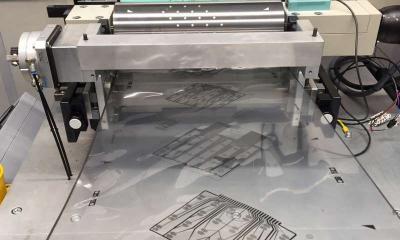Fraunhofer scientists have developed biosensors with graphene electrodes, produced cheaply and simply by roll-to-roll printing. A system prototype for mass production has already been established. This may change the current situation in which cell-based biosensors can be quite expensive to make, which often prevents them from being used. Cost factors for sensors that perform measurements electrically are the expensive electrode material and complex production.

Cell-based biosensors measure changes in cell cultures via electrical signals. This is done using electrodes which are mounted inside the Petri dish or the wells of a 'well plate'. If added viruses destroy a continuous cell layer on the electrodes, for example, the electrical resistance measured between the electrodes is reduced. In this way, the effect of vaccines or drugs (for example) can be tested: the more effective the active ingredient is, the smaller the number of cells that are destroyed by the viruses and the lower the measured resistance change will be. Also toxicity tests, such as on cosmetic products, can function according to the same principle and may replace animal experiments in the future. Another advantage is that if biosensors are linked to an evaluation unit, measurements can be continuous and automated.
The team at the Fraunhofer Institute for Biomedical Engineering IBMT has made use of such a graphene ink. Together with industry partners in the M-era.Net project BIOGRAPHY, which is funded by the German Federal Ministry of Education and Research (BMBF), the researchers have developed a printing process which makes it possible to produce large numbers of graphene biosensors in a cost-effective roll-to-roll process. "Our system prototype can print about 400 biosensors per minute on a continuous foil," says Dr. Thomas Velten, Head of the Biomedical Microsystems Department at IBMT and Project Manager of BIOGRAPHY.
While the printing equipment and graphene ink are provided by the partners involved, the scientists at the IBMT have taken care of the design of the printing process. "In particular, it is crucial to adjust parameters such as the ink viscosity, printing speed, doctor blade pressure a doctor blade wipes off excess ink and well depth of the printing cylinder so that the printed structures correspond to the nominal dimensions," explains Velten.
An interdisciplinary team of biologists and engineers from the IBMT has also developed a protein ink, which is printed directly onto the electrodes after the graphene. Velten: "It's only thanks to the proteins that the cells adhere well enough to the electrode foil". The surface energies of the foil and ink have to be adapted to one another in such a way that the transfer of the ink from the printing cylinder to the foil takes place optimally. Particularly critical is the drying of the printed structures, since the proteins do not tolerate solvents or high temperatures. Only the right mix of ink ingredients and drying method ensures that the ink will dry quickly enough.

